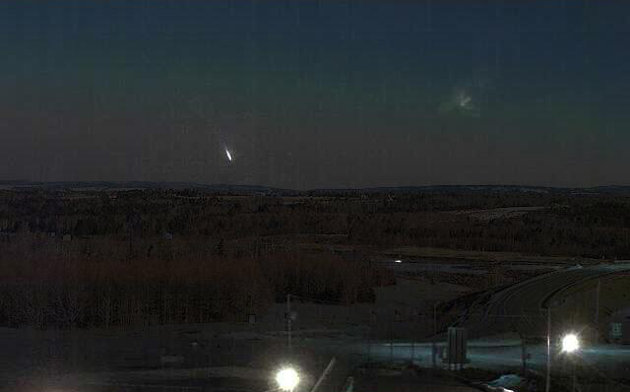
Witnesses from Nova Scotia, New Brunswick, Prince Edward Island and even Quebec's Gaspé Peninsula reported seeing a bright light in the sky early this morning. From all accounts, along with the northwest-facing image captured by the Masstown, N.S. webcam, it would seem that this particular fireball was travelling from south to north.
"On my way home from a fire call in Chateau Heights around 5 a.m. this morning, I witnessed what I thought was an airplane falling from the sky," Captain Dan Roy of the Keswick Valley Fire Department, just northwest of Fredericton, N.B., told CBC News. "There were flames and sparks and then it just disappeared. Not like any [meteor] I've ever seen before."
The fireball was apparently so bright that it woke some people from their sleep, like Rick Parker, who lives near Wentworth, N.S., about 25 kilometres north of Masstown.
"It started as a bright light. It lit up the sky enough to make me look out. I was just lying in bed, thinking about a fire in the wood stove, actually, and it lit up the whole sky. I mean it was very bright," Parker said, according to CBC News. "When I looked out the window, I just saw what appeared to be maybe the tail end of it, if you like, and it was almost like a meteor, but not the same."
Steve Betts, from Halifax spotted the fireball on his way to the airport, and paused to send out a Tweet about it:
@metrohalifax I just saw a object fall from the sky. Red flame tail, green in color, bright red flash and it disappeared .Meteorite?Cattle farmer George Hayes, who lives in Shigawake, QC, along the southeast shore of the Gaspé Peninsula, told CBC News that, at first, he thought a structure on his farm had fallen over.
- Steve Betts (@Bettszee) March 18, 2014
"It sounded a lot like thunder, it was just about 4 o'clock [ET], and we're in calving season here, so any little noise we usually awaken, and this was a loud rumble of thunder," he said. "My wife and I both woke up. I went out to check on the animals and they had been disturbed, they all ran outside and they were as startled as we were."
Witnessing fireballs in the sky is always a spectacular and memorable event, but one of the negative side effects of these events is the paranoia that usually gets spread across the Internet - specifically about 'meteor outbursts' and even potential impacts.
The truth is that while these events are spectacular, they're anything but rare. In 2013, over 3,500 fireballs were reported, and that was only to the American Meteor Society (who only records ones that happen over the U.S. and Canada). They estimate that thousands burn through the atmosphere every day. It's just that most of them aren't seen, either because they happen during the da, when they're not bright enough to be noticed, or they happen far from where anyone can see them.
Undoubtedly, some will try to tie this to asteroid 2003 QQ47, which some sites have been erroneously saying is set to impact with the Earth on Friday. After all, NASA flagged this asteroid as possibly hitting us on March 21 and this fireball flashed through the sky from south to north. 2003 QQ47's orbit is tilted on a nearly 90 degree angle compared to Earth's orbit.
However, there's no connection between the two, and 2003 QQ47 isn't even a threat to us.
Although NASA did flag a potential impact on the date 2003 QQ47 was first discovered in August 2003, within less than a month they had completely ruled out the possibility and ruled out any impacts for nearly 200 years. Also, while this fireball went south to north, 2003 QQ47 is always travelling north to south relative to Earth when it crosses our orbit, and although Earth does cross 2003 QQ47's orbital path on Friday, March 21, 2003 QQ47 isn't going to be anywhere near that point in space at the time. It will be over 23 million kilometres above Earth's orbit. For comparison, that's roughly half the distance between the orbits of Earth and Venus, so it's really far away.
The closest approach 2003 QQ47 makes to us this year is actually on March 26, at the safe distance of over 19 million kilometres. You can actually watch this flyby on the web, thanks to sites like The Virtual Telescope, who will host a live show on the 26th.



Reader Comments
to our Newsletter